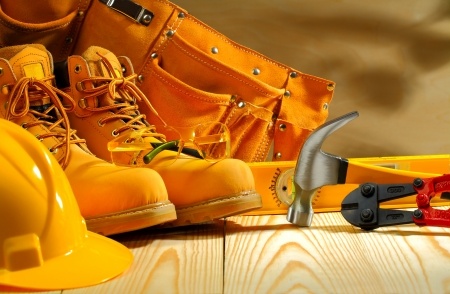Protective Footwear Reduces the Risk of Workplace Foot Injuries
By Kenton Koszdin on April 25, 2018 | In Workplace Injury
If you or someone you know works in the construction, industrial, government, or service fields, you probably have protective footwear requirements. Wearing the right safety shoes for each specific job reduces workplace injuries.
Each year, the U.S. workforce suffers 100,000 occupational foot injuries, causing an average of 10 days of missed work for each injury (U.S. Bureau of Labor Statistics, 2016). Foot injuries range from lacerations, puncture wounds and crushing to sprains and fractures.
The Occupational Safety & Health Administration (OSHA) issues and enforces regulations on personal protective equipment including footwear. Failure to comply with OSHA regulations can mean warnings, sanctions, and fines for the employer.
OSHA standards require protective footwear in areas where there is a danger of foot injuries due to falling or rolling objects, piercing objects, or electrical hazards. Situations where protective footwear is to be worn include:
- Electrical hazards
- Corrosive materials
- Potentially explosive static electricity
- Sharp objects
- Heavy objects that can roll
- Hot or slippery surfaces
ASTM Sets Performance Requirements for Protective Footwear
The American Society for Testing and Materials (ASTM) determines the performance requirements for U.S. protective footwear. Their standards are reviewed every 5 years, with the most recent review and update completed just last year.
ASTM standards establish minimum requirements for footwear performance in order to provide protection against many workplace hazards. Work shoes and boots must be labeled with ASTM specifications for consumer information. For example, protection from rolling objects is termed resistance to “Compression.” So a shoe that can withstand 2,500 lbs. of force in the toe area will be labeled as “C/75.”
Selecting the Right Shoe for the Job
Safety shoes are specific to the particular dangers in each industry and job. For example, heat-resistant shoes are required for roofing and paving work. The construction industry usually requires safety toe shoes because of the risk of dropping heavy objects on the feet. Shoes designed for electric hazards prevent the worker from completing a circuit with the ground, and those that are electrically conductive protect against the buildup of static electricity to reduce the chance of a dangerous spark.
Wear Appropriate Safety Shoes for Your Protection
It is the employer’s responsibility to ensure that their workers use protective footwear based on the workplace dangers and environment.
But workers are accountable too. Check your safety shoes regularly to make sure that they are still in good condition. If your safety toe has been hit by a heavy object, it may be compromised and need to be replaced. Any objects such as pieces of metal or contaminants embedded in the soles must be removed right away, and the sole checked for integrity.
Put safety first! Wear the right protective gear for your job, including footwear, to avoid potentially disabling injuries.
Let Us Know If You Have Been Injured on the Job
For cases related to Worker’s Compensation or Social Security Disability (SSD) benefits, it’s important to get an experienced attorney to consult with immediately. Call 800.438.7734for your initial free consultation at The Kenton Koszdin Law Office, either in our office or in the comfort of your own home. Kenton Koszdin, social security attorney in Van Nuys, CA, can help you navigate the application process for the best possible outcome for you and your family.

